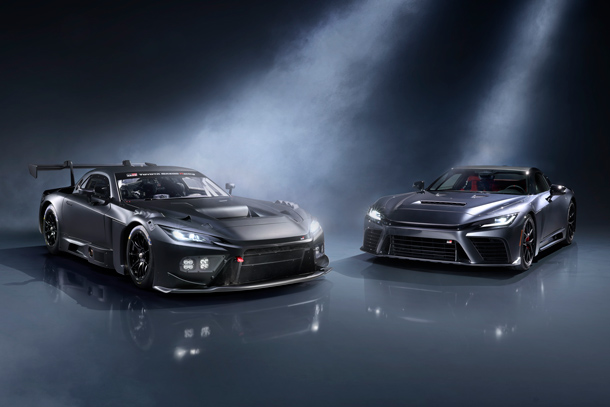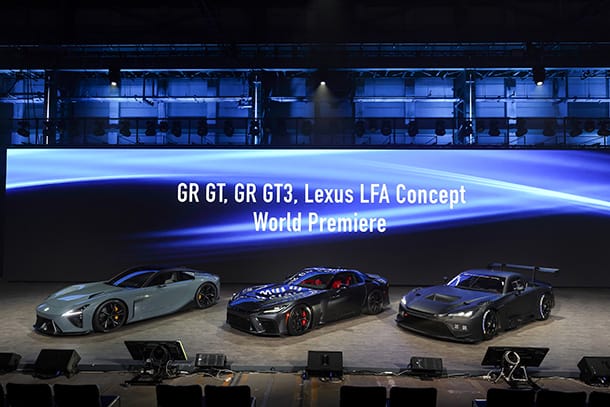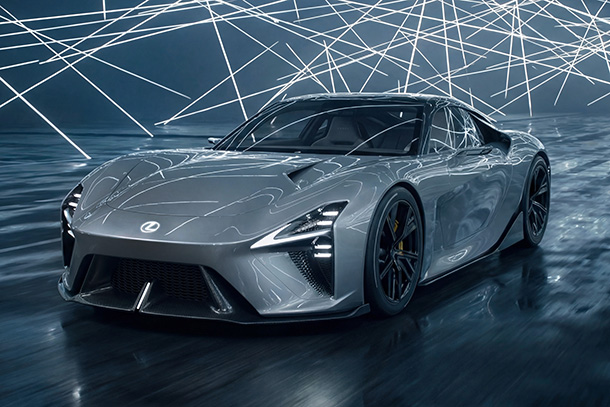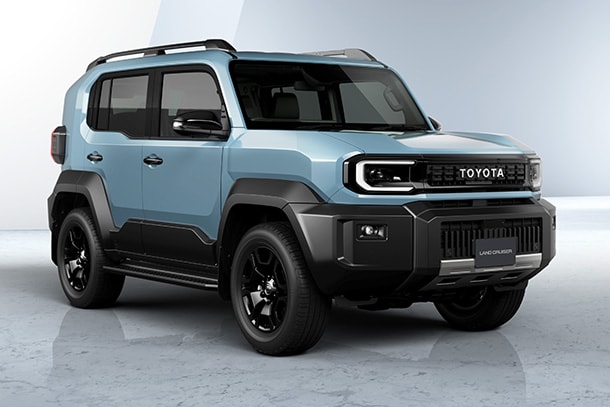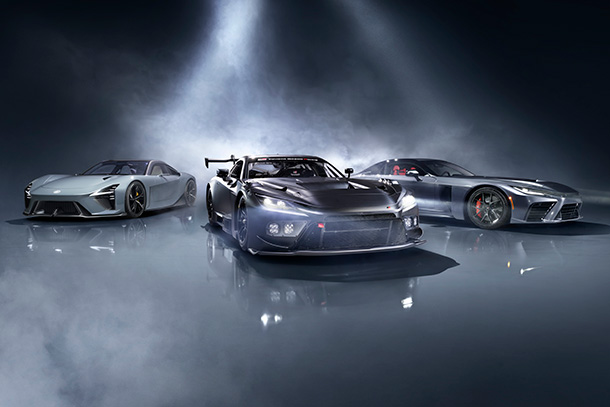Feb. 26, 2024
Developing the Smart Road Stud System (Guide Lights) to Support Mobility InfrastructureRoads Communicate with You by Light
Toyota Motor Corporation (hereafter Toyota) has declared its transformation into a Mobility Company that supports all services related to customer mobility. The Frontier Research Center is conducting research to provide services that are beneficial to pedestrians and cyclists by utilizing various information accumulated in social infrastructure for the safe operation of autonomous vehicles.
To enhance safety, it is expected that combining sensors and cameras installed in vehicles with cameras installed in infrastructure, and notifying vehicles about pedestrians and cyclists emerging from places with poor visibility or from behind obstacles, will be effective. However, it would be even safer and more reassuring if pedestrians and cyclists could be alerted in advance about the approaching vehicles. We thought that if a part of the road could emit light, it would enable two-way communication between pedestrians and vehicles, enhancing safety and creating a more secure transportation society.
Lateral thinking with mature technology
Now, I would like to introduce two important words that I keep in mind when developing something new. One is "lateral thinking with mature technology," and the other is "software-first." The first concept, "lateral thinking with mature technology," is a phrase left behind by the late Gunpei Yokoi of Nintendo, who changed the gaming world with impactful inventions. "Lateral thinking" is the opposite of "logical thinking," which refers to thinking from a different perspective, such as approaching problems from a different angle, to generate new ideas. In other words, even with mature (widely adopted and established) technology, it is possible to create innovation by combining different ideas. For example, Gunpei Yokoi successfully commercialized the Game & Watch as the next application of the LCD panels, which had been wildly used in calculators, leading to a huge hit.
-

- "Lateral thinking" and "logical thinking"
Following the concept of "lateral thinking with mature technology," while researching existing technologies, we learned about "light-emitting road studs*1" with LEDs embedded in the road. This product is embedded in the center line and the center of intersections, and it flashes at night to provide warning alerts.
-

- Light-emitting road studs manufactured by Sekisui Jushi Corporation*2
Furthermore, we found out that existing light-emitting road studs only use single-color LEDs, and most of them have a constant flashing cycle with no color variation. Therefore, we proposed to Sekisui Jushi Corporation (hereafter Sekisui Jushi), the leading manufacturer of light-emitting road studs, and KOHA Co., Ltd.*3 (hereafter Koha), a specialist of LEDs, to develop a new road stud together that can provide warning alerts with multiple colors for pedestrians and cyclists. Both companies agreed to the proposal. We named it "Smart Road Stud" to incorporate IoT technology and make it intelligent. Joint development on the project has started.
First, let's talk about LEDs. Conventional full-color LEDs are composed of three elements: red (R), green (G), and blue (B), known as RGB LEDs. White (W) is reproduced by balancing the brightness of RGB elements. However, over time, the brightness of each RGB element decreases at different rates due to degradation, and after a few years, white becomes a dull color. In industrial applications, durability is required, so four-color LEDs, which add a W element to RGB elements, are often used. Therefore, we decided to adopt four-color LEDs for the Smart Road Stud.
-

- By using four-color LEDs, we can achieve combinations of multiple colors such as white-red-blue or green-blue
Another important technology is sensors. To achieve two-way communication, we need sensors to detect the movement of pedestrians. As an indoor sensor, there is a passive infrared (PIR) sensor that uses infrared rays. However, we were informed by Koha that transparent polycarbonate resin*4 needs to be used to allow the LED light to pass through, and that polycarbonate resin cannot transmit infrared rays. This was a significant realization for us. As a result, we decided to adopt a low-cost Doppler radar method that uses radio waves as a sensor for the Smart Road Stud that can detect the movement of pedestrians.
Software-first
Next, let me introduce the second concept, "software-first." When using multiple Smart Road Studs to communicate through their lights, it is necessary to control them in coordination through a communication network. First, we considered what kind of system would be user-friendly. For example, initially, it may be sufficient to convey messages with several simple flashing patterns, but as we continue to use them, various ideas will come up. Therefore, we first introduced a mechanism*5 that allows the software of each Smart Road Stud to be rewritten later, so that we can add variations in colors and flashing patterns. In addition, we wrote the entire system in Python scripts*6 to make it easier for engineers to understand and update the functions.
Furthermore, let me share an example that we realized through the software-first approach. We implemented software that flashes multiple Smart Road Studs placed within a rectangle drawn on a simulated map. During this process, we discovered that when we rotated the rectangle, it would transform into a trapezoid. After investigation, we found that it was because the Earth is round. When expressing the four points of the rectangle in latitude and longitude, we need to perform rotation calculations that consider the Earth's curvature; otherwise, the rectangle becomes distorted. Thanks to the software-first approach, we were able to notice such a problem at an early stage.
-

- Control screen for Smart Road Stud illumination. A total of 30 Smart Road Studs are placed on a road at a test site within Toyota's testing facility
Overcoming several challenges
-

- Zoomed-in photos taken from 100 meters away. Top: a prototype with increased LED brightness, so bright that it causes overexposure. Bottom: First-generation of PoC
During the PoC*7 conducted with Sekisui Jushi and Koha using the completed Smart Road Stud, we discovered two issues. The first is the noise*8 from the motion sensors on rainy days. This noise is caused by the sensors reacting to raindrops themselves or raindrops hitting the surface of the Smart Road Stud, as well as raindrops flowing on its surface. The second issue is the insufficient distance that the LED light can reach. The 4-color LEDs used in the PoC were hobby-grade LEDs chosen for easy software development, and they were not bright enough under direct sunlight, which was the main cause. The development of the next-generation products, which address the issues identified in the PoC, is progressing smoothly.
-

- Zoomed-in photos taken from 100 meters away. Top: a prototype with increased LED brightness, so bright that it causes overexposure. Bottom: First-generation of PoC
Next, let me introduce the PoC of two-way communication using multiple Smart Road Studs. In the PoC conducted in Toyota's test site, for example, when a Smart Road Stud detects a bicycle about to emerge from the blind spot of a car, it simultaneously flashes a group of Smart Road Studs in red or yellow along the bicycle's direction to alert the car, or it sequentially lights up the Smart Road Studs along the bicycle's direction to inform the surrounding area of the bicycle's presence. Additionally, through the experiments, it was confirmed that complex flashing patterns with beautiful intermediate colors and smooth hues can attract people's attention more effectively.
Furthermore, during the "Traffic Society Experiment for the Introduction of Next-Generation Mobility" held in Kure City, Hiroshima Prefecture from January 18 to 21, 2024, the verification of Smart Road Stud's potential was conducted, and the service of Smart Road Studs alerting pedestrians when an autonomous bus approaches received positive feedback from the organizers and participants. It was also impressive that passing families and elderly people said, "What beautiful lights."
-

- Demonstration experiment in Kure City
Future prospects for Smart Road Studs
Through the experiments, we realized that to increase the Smart Road Studs' expressive capabilities, it is necessary to develop a wide variety of lighting patterns. We also came up with ideas such as providing directions to destinations and supporting comfortable walking by adjusting the flashing cycle based on the pedestrian's walking speed, not just alerting to dangers. Furthermore, recycling is also an important element. We are considering using materials that make recycling easy, taking into account the disposal of Smart Road Studs due to the deterioration of roads.
The ultimate goal of this technology is for "roads to watch over people." Currently, many people may feel uneasy walking alone on the road at night, but we hope that in the future, this technology will become widespread, and roads surrounded by the light of Smart Road Studs 24 hours a day will increase, allowing people to walk with peace of mind at any time.
-

- Smart Road Stud illumination demonstration
-

- Photos of the project members
Left: Toyota (From left; Oikawa, Oya, Mikami)
Middle: Sekisui Jushi (From left; Miyashita, Takagi, Igarashi)
Right: Koha (Back row, from left; Yamada, Takayanagi, T. Yoshida, S. Yoshida, Sano. Front row, from left; Matsuzawa, Imada, Minatoya, Ibuki)
References
| *1 | Light-emitting road studs manufactured by Sekisui Jushi |
|---|---|
| *2 | Sekisui Jushi Corporation |
| *3 | KOHA Co., Ltd. |
| *4 | Used in car headlights, among other applications. |
| *5 | Also known as Over The Air (OTA) updates. It refers to the process of updating software and synchronizing data wirelessly. |
| *6 | Some parts also utilize JavaScript. |
| *7 | Proof of Concept, which means confirming the principle. In the final stage of product development, a test product is created to connect to production and mass production. |
| *8 | Unnecessary elements or parts of signals, data, and information that are not required for a specific purpose and are handled as the target. |
Author
Susumu Oikawa
Project Manager, Infrastructure System Group No.1, R-Frontier Division, Toyota Motor Corporation
Contact Information (about this article)
- Frontier Research Center
- frc_pr@mail.toyota.co.jp


